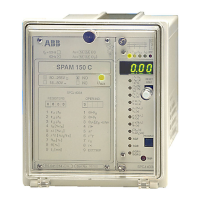11
Motor protection relay module SPCJ 4D34
Thermal overload unit
Setting of full load current, I
θ
0.5...1.50 x I
n
Resolution of current setting 0.01 x I
n
Setting of maximum stall time, t
6x
2.0...120 s
Resolution of stall time-setting 0.5 s
Cooling time-constant k
c
at zero current (standstill) 1...64 x the heating time constant
Thermal prior alarm level θ
a
, if in use 50...100% of the thermal trip level θ
t
Restart inhibit level θ
i
20...80% of the thermal trip level θ
t
Thermal unit initialization after an auxiliary
supply interrupt *) 70% of the thermal trip level θ
t
,
i.e. hot motor
Low-set overcurrent unit **)
Setting range for I> 1.0...10.0 x I
n
Operate time t> 0.3…80 s
Current based start-up supervision **)
Startup current setting range I
s
1.0...10.0 x I
n
Startup time setting range t
s
0.3…80 s
Shortest operate time ~300 ms
High-set overcurrent unit
Setting range for I>> 0.5...20.0 x I
n
and ∞, infinite
Operate time t>> 0.04...30 s
Earth-fault protection unit
Setting range for I
0
1.0...100% I
n
Operate time t
0
0.05...30 s
Attenuation of the third harmonic, typ. -20 dB
Phase unbalance unit
Basic sensitivity ∆I, stabilized to phase current
levels below I
θ
10...40% x I
L
and ∞, infinite
Operate time at lowest settable pick-up level, 10 % 20...120 s, inverse time
Operate time at full unbalance (single phasing) 1 s
Operate time incorrect phase sequence protection 600 ms
Undercurrent unit
Start current I< in per cent of the full load
current setting 30...80% I
θ
or out of operation
Operation inhibited below level 12% I
θ
Operate time 2...600 s
Time-based start inhibit counter
Setting range ∑t
si
5...500 s
Countdown rate of start time counter ∆t
s
/∆t 2...250 s / h
Note!
*) If the thermal prior alarm is set below 70%, the connection of the auxiliary supply to the relay
will cause a thermal prior alarm signal.
**)The operation can be defined either as a low-set definite time overcurrent function (SGF/7 = 0)
or as a current based start-up supervision function (SGF/7=1). Both functions cannot be used
at the same time. In either case, the time-counting can be stopped by a control signal to the speed
switch input (SGB/1 =1).

